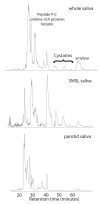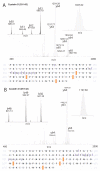Confident assignment of intact mass tags to human salivary cystatins using top-down Fourier-transform ion cyclotron resonance mass spectrometry
- PMID: 20189825
- PMCID: PMC2873128
- DOI: 10.1016/j.jasms.2010.01.025
Confident assignment of intact mass tags to human salivary cystatins using top-down Fourier-transform ion cyclotron resonance mass spectrometry
Abstract
A hybrid linear ion-trap Fourier-transform ion cyclotron resonance mass spectrometer was used for top-down characterization of the abundant human salivary cystatins, including S, S1, S2, SA, SN, C, and D, using collisionally activated dissociation (CAD) after chromatographic purification of the native, disulfide intact proteins. Post-translational modifications and protein sequence polymorphisms arising from single nucleotide polymorphisms (SNPs) were assigned from precursor and product ion masses at a tolerance of 10 ppm, allowing confident identification of individual intact mass tags. Cystatins S, S1, S2, SA, and SN were cleaved of a N-terminal 20 amino acid signal peptide and cystatin C a 26-residue peptide, to yield a generally conserved N-terminus. In contrast, cystatin D isoforms with 24 and 28 amino acid residue N-terminal truncations were found such that their N-termini were not conserved. Cystatin S1 was phosphorylated at Ser3, while S2 was phosphorylated at Ser1 and Ser3, in agreement with previous work. Both cystatin D isoforms carried the polymorphism C46R (SNP: rs1799841). The 14,328 Da isoform of cystatin SN previously assigned with polymorphism P31L due to a SNP (rs2070856) was found only in whole saliva. Parotid secretions contained no detectable cystatins while whole saliva largely mirrored the contents of submandibular/sublingual (SMSL) secretions. With fully characterized cystatin intact mass tags it will now be possible to examine the correlation between the abundance of these molecules and human health and disease.
Copyright 2010 American Society for Mass Spectrometry. Published by Elsevier Inc. All rights reserved.
Figures





Similar articles
-
Salivary Cystatins: Exploring New Post-Translational Modifications and Polymorphisms by Top-Down High-Resolution Mass Spectrometry.J Proteome Res. 2017 Nov 3;16(11):4196-4207. doi: 10.1021/acs.jproteome.7b00567. J Proteome Res. 2017. PMID: 29019242
-
Protein-Sequence Polymorphisms and Post-translational Modifications in Proteins from Human Saliva using Top-Down Fourier-transform Ion Cyclotron Resonance Mass Spectrometry.Int J Mass Spectrom. 2007 Dec 1;268(2-3):190-197. doi: 10.1016/j.ijms.2007.08.008. Int J Mass Spectrom. 2007. PMID: 19050733 Free PMC article.
-
Identification of full-sized forms of salivary (S-type) cystatins (cystatin SN, cystatin SA, cystatin S, and two phosphorylated forms of cystatin S) in human whole saliva and determination of phosphorylation sites of cystatin S.J Biochem. 1991 Oct;110(4):648-54. doi: 10.1093/oxfordjournals.jbchem.a123634. J Biochem. 1991. PMID: 1778989
-
Salivary (SD-type) cystatins: over one billion years in the making--but to what purpose?Crit Rev Oral Biol Med. 2002;13(6):485-508. doi: 10.1177/154411130201300606. Crit Rev Oral Biol Med. 2002. PMID: 12499242 Review.
-
'Top down' protein characterization via tandem mass spectrometry.J Mass Spectrom. 2002 Jul;37(7):663-75. doi: 10.1002/jms.346. J Mass Spectrom. 2002. PMID: 12124999 Review.
Cited by
-
Significant modifications of the salivary proteome potentially associated with complications of Down syndrome revealed by top-down proteomics.Mol Cell Proteomics. 2013 Jul;12(7):1844-52. doi: 10.1074/mcp.M112.026708. Epub 2013 Mar 26. Mol Cell Proteomics. 2013. PMID: 23533003 Free PMC article.
-
Top-Down Characterization of the Post-Translationally Modified Intact Periplasmic Proteome from the Bacterium Novosphingobium aromaticivorans.Int J Proteomics. 2013;2013:279590. doi: 10.1155/2013/279590. Epub 2013 Mar 10. Int J Proteomics. 2013. PMID: 23555055 Free PMC article.
-
Impairment of mitochondria in adult mouse brain overexpressing predominantly full-length, N-terminally acetylated human α-synuclein.PLoS One. 2013 May 7;8(5):e63557. doi: 10.1371/journal.pone.0063557. Print 2013. PLoS One. 2013. PMID: 23667637 Free PMC article.
-
RP-HPLC-ESI-IT Mass Spectrometry Reveals Significant Variations of the Human Salivary Protein Profile Associated with Predominantly Antibody Deficiencies.J Clin Immunol. 2020 Feb;40(2):329-339. doi: 10.1007/s10875-020-00743-4. Epub 2020 Jan 8. J Clin Immunol. 2020. PMID: 31916122
-
Electrochemistry-assisted top-down characterization of disulfide-containing proteins.Anal Chem. 2012 Apr 17;84(8):3838-42. doi: 10.1021/ac300106y. Epub 2012 Apr 4. Anal Chem. 2012. PMID: 22448817 Free PMC article.
References
-
- Kelleher NL, L H, Valaskovic GA, Aaserud DJ, Fridriksson EK, McLafferty FW. Top down versus bottom up protein characterization by tandem high-resolution mass spectrometry. J. Am. Chem. Soc. 1999;121:806–807.
-
- Loo JA, Edmonds CG, Smith RD. Primary sequence information from intact proteins by electrospray ionization tandem mass spectrometry. Science. 1990;248:201–204. - PubMed
-
- Edgar WM. Saliva: its secretion, composition and functions. Br Dent J. 1992;172:305–312. - PubMed
Publication types
MeSH terms
Substances
Grants and funding
LinkOut - more resources
Full Text Sources
Molecular Biology Databases
Miscellaneous

